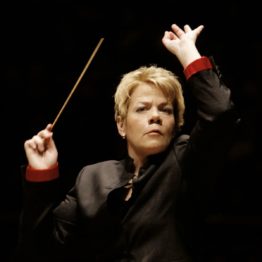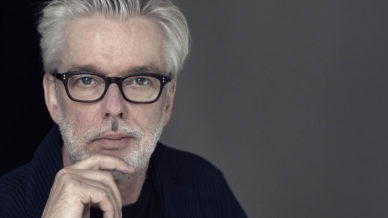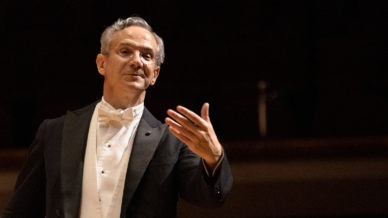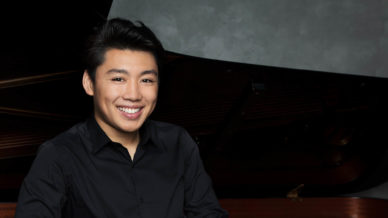

Alsop dirige Scheherazade
23 - 25 de febrero de 2023
MARIN TAMBIÉN lleva a cabo
GABRIELA MONTERO piano
GABRIELA ORTIZ Antrópolis
GABRIELA MONTERO Concierto para piano nº 1 "Latino"
RIMSKY-KORSAKOV Scheherazade
Para abrir el programa, la compositora mexicana Gabriela Ortiz hace gala del timbal de la DSO con su obra Antrópolis. A continuación, "la reina de la improvisación" (Associated Press), Gabriela Montero, interpretará su propio Concierto para piano "latino", que honra el espíritu de América Latina.
El programa concluye con la mundialmente conocida directora Marin Alsop uniéndose a la DSO para la aventurera Scheherazade de Rimsky-Korsakov, que ilustra los fantásticos cuentos de su Reina Persa. Colores orquestales evocative y motivadores solos instrumentales narran el exótico viaje de amor, peligro e intriga inspirado en la colección de cuentos populares medievales de Oriente Medio "Las mil y una noches".
MORTON H. MEYERSON SYMPHONY CENTER
2301 Flora St.
Dallas, TX 75201

Notas del programa
por René Spencer Saller
Born in Mexico City to folk-musician parents, Ortiz started playing piano at eight and knew that she wanted to be a composer before she entered her teens. She studied at the National Conservatory of Music with Mario Lavista and at the National University of Mexico with Federico Ibarra. In 1990, after receiving the British Council Fellowship, she studied in London with Robert Saxton at The Guildhall School of Music and Drama. In 1992 she received a scholarship from the University of Mexico that funded a doctorate in electroacoustic music composition with Simon Emmerson at The City University in London. She currently teaches composition at the Mexican University of Mexico City, and her music is published by Boosey & Hawkes.
The recipient of many honors and awards, including the National Prize for Arts and Literature (Mexico), as well as Guggenheim and Fulbright Fellowships, Ortiz has composed operas, orchestral works, music for chamber ensembles, and dance and film scores. Recent commissions include Clara for orchestra (The New York Philharmonic); Altar de Cuerda for violin and orchestra (The Los Angeles Philharmonic); and Tzam for orchestra (Cincinnati Symphony Orchestra).
Ortiz was named a member of El Colegio Nacional (The National College) in 2022. Created in 1943 by presidential decree, this exclusive honorary academy brings together Mexico’s leading artists and scientists, who deliver lectures and seminars in their areas of expertise. Also in 2022 Ortiz was appointed curator of the Pan-American Music Initiative in conjunction with The Los Angeles Philharmonic and the conductor Gustavo Dudamel, an enthusiastic promoter of Ortiz’s career.
Ortiz’s parents cofounded Los Folkloristas in 1966, when Ortiz was a toddler. Members of this legendary ensemble continue to serve as ambassadors of traditional Latin folk music, which is also Ortiz’s goal—or one of them, anyway. Loaded with intoxicating polyrhythms and spiky syncopation, the orchestral piece Antrópolis evokes and reimagines the popular Mexican dance music of the 1940s and ’50s. Antrópolis, which might be translated as “Human City,” is scored for an unusual array of percussion instruments (bongos, maracas, cowbells, glockenspiels, and more) and opens with a spirited, lengthy—and dare I say deeply funky? —drum solo.
Fulfilling a commission by the internationally renowned Mexican conductor Carlos Miguel Prieto, Ortiz completed Antrópolis in early 2018. Prieto led the Orquestra Sinfónica in the world premiere on April 1, 2018, at the Palacio de Bellas Artes, in Mexico City.
Habla el compositor
“I really enjoy dancing, for many years I went to all the clubs, visiting the Colonia Hall, the Los Angeles Hall, the Mexico Hall…. I really like the mambo; I am an admirer of Pérez Prado….
“I have always wanted to do an orchestral piece… but suddenly, why not, make it fun, sometimes everything is so intense, so why not do this side of enjoyment, pastiche, potpourri of dance clubs and lounges, especially the old ones, which are the ones that I like best.”—Gabriela Ortiz, excerpted from a 2018 interview
An improviser of breathtaking skill and ingenuity, Montero ranks among the most original pianists on the planet. Like Ortiz, she collaborates regularly with the conductor Carlos Miguel Prieto. In 2015 Montero won a Latin Grammy Award for her album Ex Patria, a meditation on her native Venezuela. She combines virtuosic technique with a prodigious imagination, capable, at a moment’s notice, sometimes at the request of an audience member, of whipping up a complex set of variations, adorned with harmony, counterpoint, and an infinite array of rhythmic patterns and procedures. Like a seasoned jazz musician, she can compose so fluently, so spontaneously, that it seems like a form of thinking out loud, or some kind of spooky prescience. She reminds us that the word “prodigy” is derived from the Latin word prodigium, which means “omen” or “monster.”
Montero performed the world premiere of her Piano Concerto No. 1,”Latin,” in 2016, at the Leipzig Gewandhaus, and released a recorded performance of it with Prieto and the Orchestra of the Americas on Orchid Classics three years later.
Habla el compositor
“My story is a modern one, in many ways. I was born and raised in Venezuela until the age of eight, at which point my family moved with me to the United States for a decade. I landed at the Royal Academy of Music in London in my early 20s. I am a globalized, Latin American woman raised on a diet of European classical music with multiple, circumstantial side dishes of Pan-American folklore.
“I also consider myself to be a musician whose primary role is to tell stories that reflect the wide gamut of human experience across both time and geography. Every era and continent has its story to tell, however joyful or troubling, from Renaissance Europe to the contemporary Americas, and composers are well positioned not only to tell it, but to provide a unique form of social commentary.
“The piano is my chosen instrument as a performer, but not my only narrative tool as a composer and communicator. It should come as no surprise, then, that my first concerto should be written for the piano as solo instrument, and that it should employ traditional, European musical structures to tell my contemporary story as a well-traveled Latin-American woman.
“In a process of musical osmosis—a natural consequence of the globalized, interconnected world in which we now live—my Piano Concerto No. 1, the ‘Latin’ Concerto, honors the musical traditions that have shaped me, while inviting the cultural idioms of my native continent to the concert halls of Europe and the wider world. European formalism and the informality of Latin America’s rich, rhythmical identity merge in a complementary dance of both the joyful and macabre.
“Writing my Concerto, I set out to describe the complex and often contradictory character of Latin America, from the rhythmically exuberant to the forebodingly demonic. Unlike my previous work for piano and orchestra—the specifically Venezuelan polemic Ex Patria (2011), a musical portrait of a country in collapse—the ‘Latin’ Concerto draws upon the spirit of the broader South American continent. For every suggestion of surface celebration in the first-movement Mambo, for instance, there are undercurrents of disruption. The third-movement Allegro Venezolano, which cites the well-known Venezuelan Pajarillo, is interrupted at times by the dark arts of black magic, a symbolic reminder of the malevolent forces that, too often, hold our continent hostage to tyranny in its multiple guises. —Gabriela Montero
The American novelist and photographer Carl Van Vechten once called the Russian composer Rimsky-Korsakov “a musical Eurasian.” To 21st-century ears, that label sounds problematic (not to mention inaccurate), but Van Vechten—a white man deeply committed to the Black-led Harlem Renaissance artistic movement—meant it as a compliment.
Scheherazade was inspired by The Arabian Nights o A Thousand and One Nights, an ancient compendium of Arabic, Persian, and Indian tales. Rimsky-Korsakov titled his symphonic suite for the heroine whose dilemma frames the tales: Scheherazade, who keeps her homicidal freak of a husband from killing her by hooking him on her fiction. After each new cliffhanger, the story-loving sultan postpones her execution, night after night, until finally he decides to spare her.
Although Rimsky-Korsakov acknowledged that Scheherazade consisted of “separate, unconnected episodes and pictures from The Arabian Nights,” with a unifying theme representing Scheherazade herself, he tried not to get bogged down in too much extramusical detail. In his memoir he described his artistic goals: “All I had desired was that the listener, if he liked my piece as symphonic music, should carry away the impression that it is beyond doubt an Oriental narrative of some numerous and varied fairy-tale marvels and not merely four pieces played one after another and composed on the basis of themes common to all four movements.”
Seascapes and Soundtracks
Rimsky-Korsakov’s descriptive titles refer to iconic scenes in the collection, not to specific stories. The first, “The Sea and Sinbad’s Ship,” juxtaposes a harsh, articulated theme, which may represent the Sultan or possibly Sinbad, and a sinuous legato motif, sung by solo violin, that suggests the beguiling voice of Scheherazade herself. The concerto-like second movement, “The Story of the Kalender Prince,” highlights various solo instruments and instrumental groupings as it enacts the many transformations of a masquerading prince. The most overtly Romantic movement, “The Prince and the Princess” is a rapturous romp that wouldn’t sound out of place on the soundtrack of a late-1940s Hollywood melodrama.
Shipwrecks, Seductions, and Salvation
The finale contains three parts: “Festival at Baghdad,” “The Sea,” and “The Ship Is Dashed Against a Rock Surmounted by a Bronze Warrior.” Like the first movement, it opens with dramatic elaborations of the contrasting Sultan and Scheherazade themes. The mood is lively, almost nerve-wracking in its profuse variations. Strings scurry, brass stutters, and as the hysteria mounts, in come the lordly trombones intoning their grim message against a maelstrom of strings, winds, and percussion. A more ominous passage ensues, pierced by the doomy clash of a gong. Then, accompanied by gentle winds and delicate harp, Scheherazade sashays back with an acutely seductive take on her by now familiar violin theme. She has saved her own life and maybe the soul of a despot, too. As the suite closes, the violin holds one long, impossibly sweet and sustaining high note.




